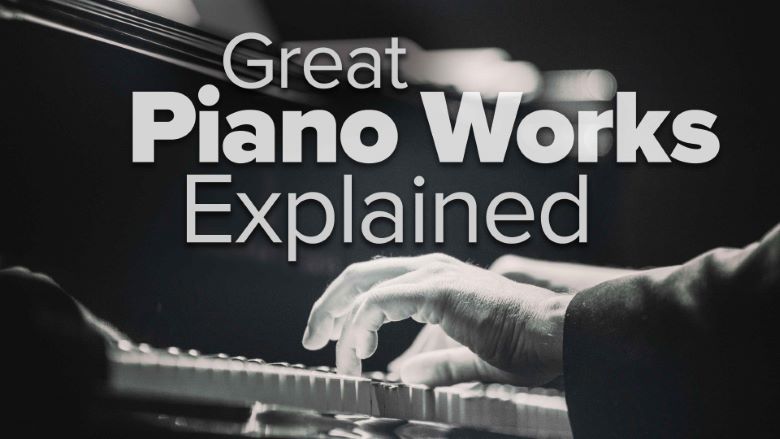The piano—with its rich tonal resources, orchestral textures, and ability to convey both melody and harmony—has attracted great composers throughout its history. The result is a repertoire of keyboard works of astonishing size and scope, going far beyond that of any other musical instrument.
This phenomenal repertoire, which spans more than 300 years of Western music, includes many of classical music’s most beloved masterpieces. Treasures of this tradition include:
- The Baroque-era genius of Johann Sebastian Bach, whose preludes and fugues, toccatas, and suites set the standard for keyboard writing.
- Sonatas, variations, and related piano works by Classical giants Wolfgang Amadeus Mozart, Joseph Haydn, Ludwig van Beethoven, and the transitional figure of Franz Schubert.
- Romantic masterworks ranging from Frederic Chopin’s mazurkas, nocturnes, and ballades and Robert Schumann’s multi-form piano works to Johannes Brahms’s variations and glorious small-scale pieces, and Franz Liszt’s virtuosic Hungarian Rhapsodies.
- At the turn of the 20th century, the mystical piano works of Aleksandr Scriabin, and the impressionistic textures of Claude Debussy’s and Maurice Ravel’s keyboard writing.
- A dazzling spectrum of 20th- and 21st-century piano music, pioneering new forms and new tonalities, from Arnold Schoenberg, Sergei Prokofiev, and Charles Ives to George Crumb, Florence Price, and George Walker, all of whom extended the expressive voice of the piano.
These works and many more form the piano literature that continues to move and enchant us; it comprises one of the most powerful legacies in Western art.
In Great Piano Works Explained, you’ll dig deeply into this magnificent tradition, in a far-reaching exploration of the art of listening, seen from the bench of a pianist. In these 24 musically rich lectures, taught with passion and deep insight by Professor Catherine Kautsky of Lawrence University, you’ll encounter the composers named above and more, finding your way to the heart of their extraordinary music for the piano.
Experience the Sublime Richness of the Piano Repertoire
In this illuminating course, Professor Kautsky coaches you in hearing and understanding the great works for the piano, with a special feature: In addition to her esteemed teaching, she is a celebrated pianist, and she demonstrates the works under discussion in real-time, at the keyboard, illustrating both excerpts and entire works through her own expressive and thoughtful playing.
With her inspired guidance, you’ll highlight key works of each composer, and unpack their structure, the musical materials that drive them, and the specific features that affect listeners so strongly, giving you a clear grounding in how to approach and hear this great music.
Within the Baroque and Classical periods, you’ll look in depth at works such as:
- Bach’s Well Tempered Clavier and French Suite No. 5—Discover the radiant beauty of Bach’s keyboard creations in the brilliant counterpoint of two fugues from the “WTC,” and in the emotional range of this vibrant dance suite.
- Mozart’s Sonata in C Minor, K. 457—Hear the influence of opera in this intense and tempestuous sonata, where Mozart uses dialogue between opposing themes and magical key changes to transport the listener from joy to sorrow, and back again, in an ever-changing kaleidoscope of emotions.
- Beethoven’s Sonata Opus 110—In this monumental late sonata, witness how Beethoven constructs the work as an unforgettable musical journey; study the majestic first movement, the dramatic Allegro molto, and the Arioso and great fugue that ends the sonata in triumphant affirmation.
- Schubert’s Sonata in Bb, D. 960—This large-scale sonata, written in the last year of Schubert’s life, features unforgettable themes and an intriguing dichotomy between keys. Tour the first movement: You’ll love the melodies, and you’ll see how one small trill gives rise to the harmonic plan of the entire work.
In exploring these extraordinary works, you’ll learn about the structural forms that underlie the music. As a case in point, you’ll take a penetrating look at sonata form, a core musical structure that has influenced Western classical music for 250 years. As Professor Kautsky explains, “Sonata form demands conflict; above all, between keys. We’ll have an exposition that “exposes” two keys, a development that prolongs the tension between them, and a recapitulation that provides reconciliation.” As a tool for listening, this understanding of the structure of the music makes the unfolding musical narrative clear and accessible.
Explore the Expressive Range of a Magnificent Instrument
Throughout the course, you’ll examine the remarkable ways that composers have used the resources of the piano to create vastly different musical and expressive effects. They range from Bach’s masterful, contrapuntal keyboard writing and Schubert’s songlike lyricism to the dramatic textures of Brahms, the otherworldly tonalities of Debussy, and the jagged dissonance of Alban Berg and other modernist masters.
As exemplars of grand Romantic keyboard writing, you’ll delve into:
- Schumann’s Kreisleriana, Papillons, and Carnaval—Delight in the resplendent musical tapestries of Schumann’s piano “cycles,” anthology-like works which give free rein to his wild, kaleidoscopic imagination, revealing multiple musical “characters” and sonic landscapes.
- Chopin’s Ballade in F Minor—In one of the supreme Romantic masterpieces for the piano, grasp how Chopin delivers a seemingly epic musical narrative within twelve minutes, moving from lyric tenderness and deep sentiment to a passionate, thunderous denouement.
- Liszt’s Petrarch Sonnet No. 104—From the piano’s most swashbuckling virtuoso, savor the contours of this ruminative, evocative pianistic poem. It’s based on Petrarch’s ode to despairing, unrequited love, and its rich, chromatic harmonies and impassioned thematic development do the poetry full justice.
Refine the Skills of Listening to Great Music
Parallel with these evolving musical creations came remarkable developments in the instrument itself, mechanical innovations that extended the tonal resources of the piano, as well as its carrying power, giving us the modern concert grand piano, an acoustic instrument that can fill an opera house with sound.
In these lectures, you’ll learn how the developing features of the instrument itself inspired composers, and how they employed them, from Mozart’s use of dynamics (gradations of sound from very soft to very loud) and Chopin’s use of the pedal, bathing the piano’s sonorities in overtones, to Sergei Rachmaninoff’s pyrotechnical keyboard virtuosity and Béla Bartók’s use of the percussive possibilities of the modern piano.
And, through Professor Kautsky’s commentary and expert playing, you’ll learn about the specific techniques of touch, articulation (notes that are sounded separately or linked together), phrasing (the shaping of melodies), and expressive pedaling that realize the composers’ directions to the pianist and bring the music to life in performance.
As the lectures enter the 20th and 21stcenturies, you’ll encounter:
- Debussy’s Claire de Lune and Preludes. Grasp the compositional means behind one of the most beloved pieces in the repertoire—the ethereal, floating Claire de Lune, and taste the exoticism, humor, and flights of fancy of Debussy’s incandescent Preludes.
- Schoenberg’s Sechs kleine Klavierstücke and Berg’s Sonata for Piano. From the man who coined the phrase, “the emancipation of dissonance,” you’ll encounter a new harmonic language, and in the jarring tonalities and anguish of the Klaviersonate by his student, Alban Berg, you’ll hear the tensions that spawned much of the 20th century’s music.
- Charles Ives’ Concord Sonata. In this American innovator’s magnum opus, inspired by the 19th-century transcendentalist writers, unconventional harmonies, dense textures, and multiple musical quotations all coexist in a massive, sprawling artistic statement.
In Great Piano Works Explained, you’ll study masterpieces from a wide selection of the great composers, deepening your skill in hearing, understanding, and appreciating these timeless creations of the human spirit.
01 J. S. Bach and The Well-Tempered Clavier
02 Bachs French Suites
03 Joseph Haydns Early Classical Piano
04 Mozarts High Classical Piano
05 Mozarts Sonata in C Minor, K. 457
06 Beethovens Sonata in F Minor, Op. 2, No. 1
07 Beethovens Sonata No. 31, Op. 110, Movt. 1
08 Beethovens Sonata No. 31, Op. 110, Movts. 2-3
09 The Songs of Franz Schubert
10 Schuberts Sonata in B-flat Major, D. 960
11 Robert Schumanns Romantic Dream World
12 Clara Schumann and the Plight of Women Composers
13 Frederic Chopin Pianos Quintessential Romantic
14 Chopins Nocturnes and Ballades
15 Johannes Brahms Pianos Dark Poet
16 Franz Liszt The Consummate Pianist
17 The Rise of the Russian Pianists
18 Arnold Schoenberg, Alban Berg, and Anton Webern
19 Claude Debussys Clair de lune
20 The Preludes of Debussy
21 French Piano in the Early 20th Century
22 Charles Ives, Sergei Prokofiev, and Bela Bartok
23 Marginalized Composers
24 New Sounds for a New Century
Trailer


